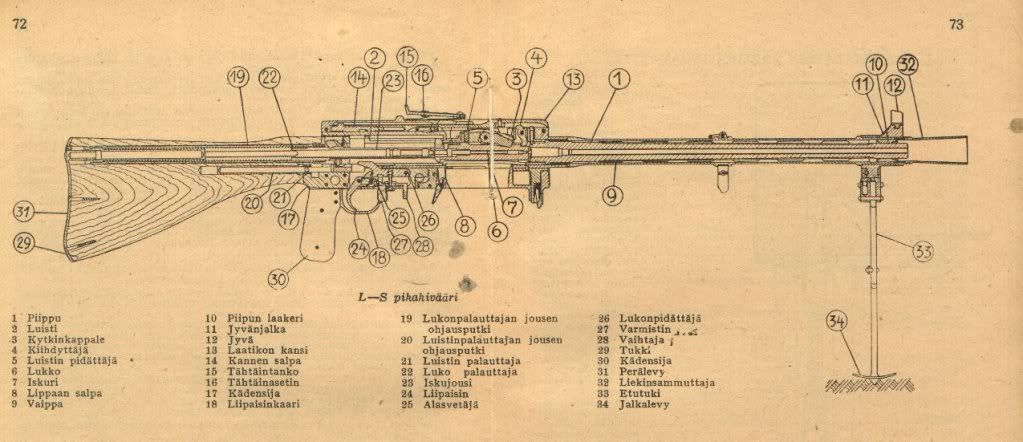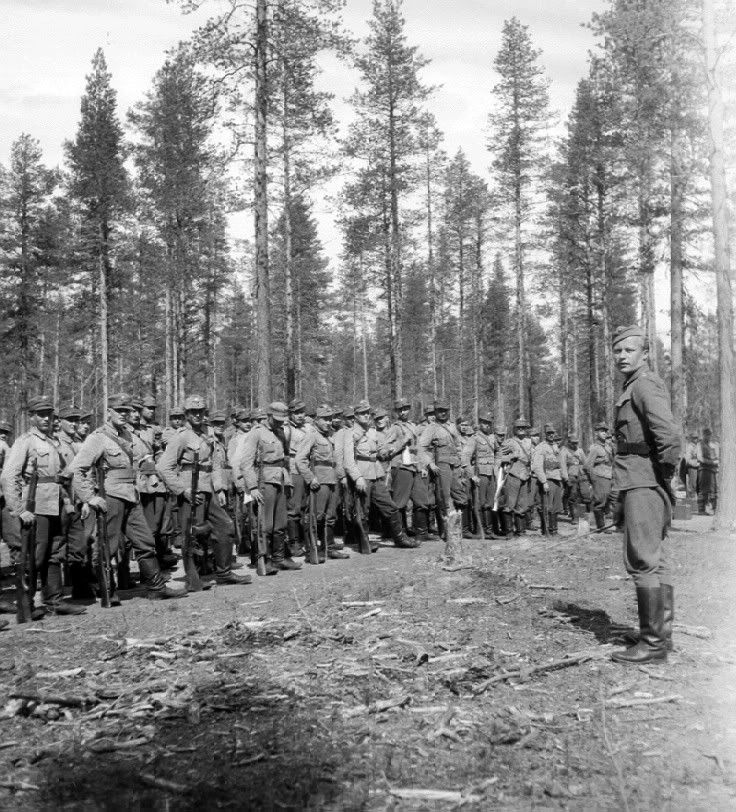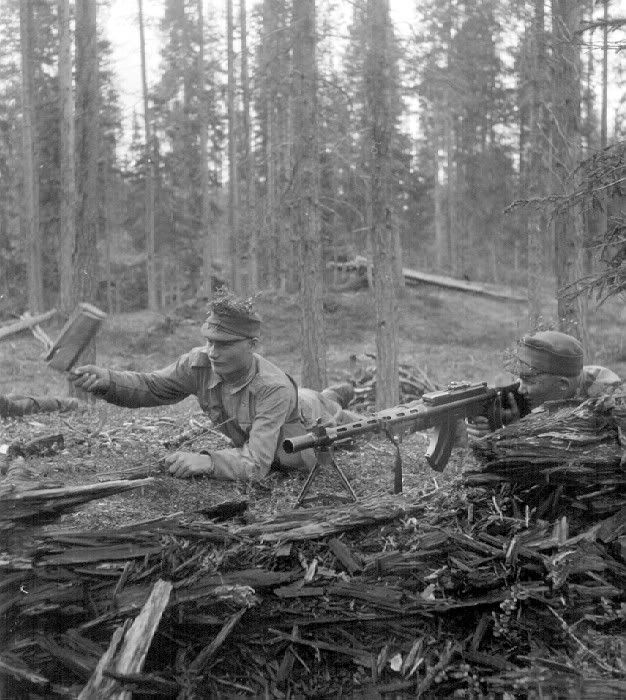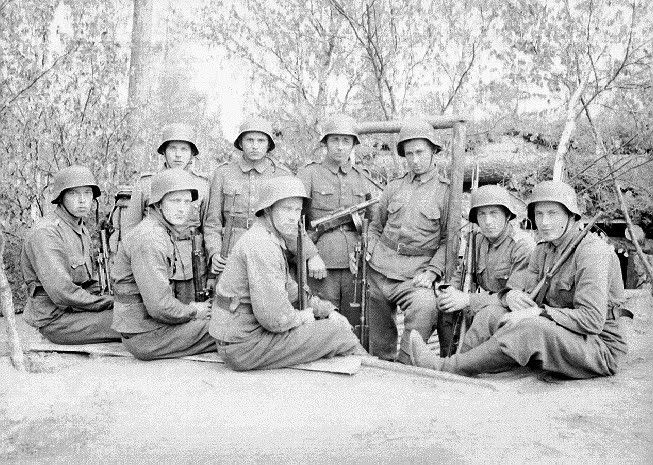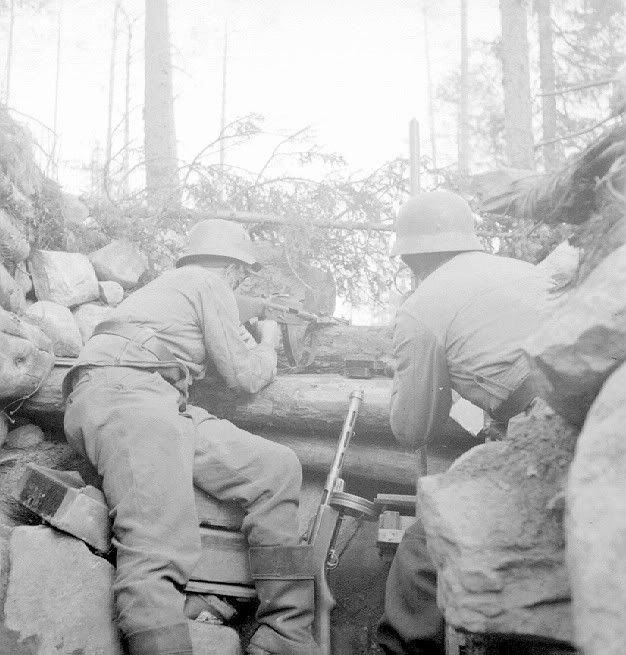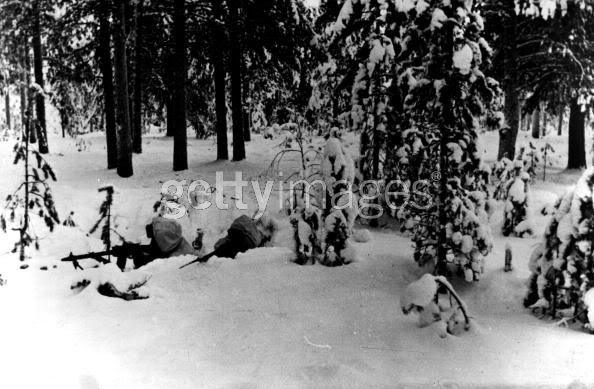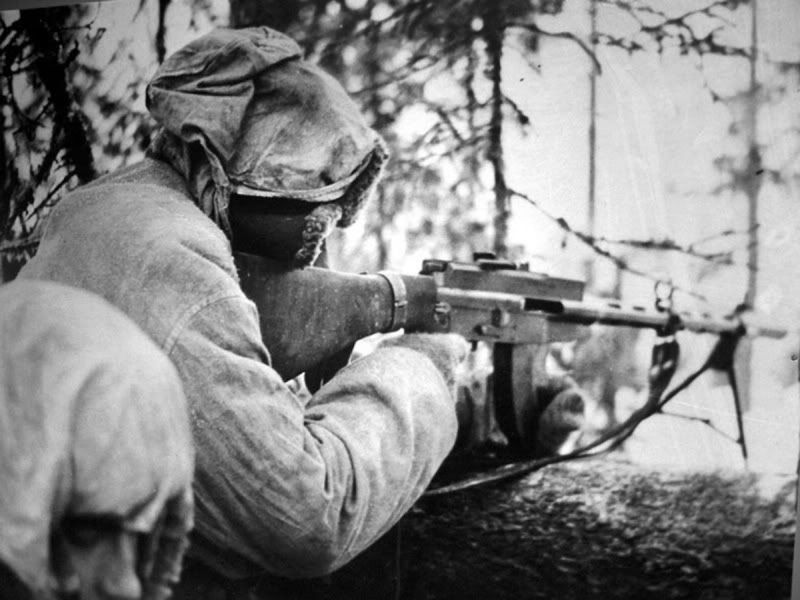The Valtion Kivääritehdas (State Rifle Factory) at Jyäskylä, Finland, produced in 1926 a light machine gun that operated on the short recoil system. It was the invention of Finland's most outstanding automatic weapon designer. Aimo Johannes Lahti, who for a number of years was chief of this government arsenal. Lahti originated weapons for his country's use in all sizes from rifle caliber to cannon and, unlike most inventors, did not exploit a single basic system of operation but employed various methods ranging from short recoil to gas.
The Lahti (Suomi), or L/S, light machine rifle was one of his most refined models and was later used extensively by his countrymen in the Russian campaign. It was greatly respected by the Soviets and copied extensively by them. Ironically, while the Finns produced it primarily for sale either to England or to Germany, they were forced to use it first in defense of their homeland. The weapon, as modified in 1932, was given the factory designation, L/S Machine Rifle Model 26-32. It was air cooled and could be fired both full automatic and single shot.
The physical appearance of the weapon was practically the same as a standard army rifle and it was pointed out by the promoters that one infantryman armed with the L/S 26-32 could lay down as much fire power as an ordinary company firing the bolt-action rifle.
This weapon was produced originally for possible sale to the two major powers, England and Germany, which the Finns felt were potential enemies of each other. The weapon was chambered for each country's cartridge and it was especially designed so that, by merely switching the barrel and bolt, either cartridge could be used.
As evidence that the producers of the L/S 26-32 used this method of impartially seeking the business of both sides in any future war, a portion of a promotional booklet dated 1933 is quoted:
"The greatest advantage of this machine gun is that it at last solves the problem of a universal machine rifle of different calibers. It is designed so that after fitting in different operational parts the firing of cartridges of different calibers is possible. At present machine guns with firing mechanisms for British and German army cartridges are being made. During the manufacture, trials have also been made with 7.9-mm and 6.5-mm military cartridges and it was proved then
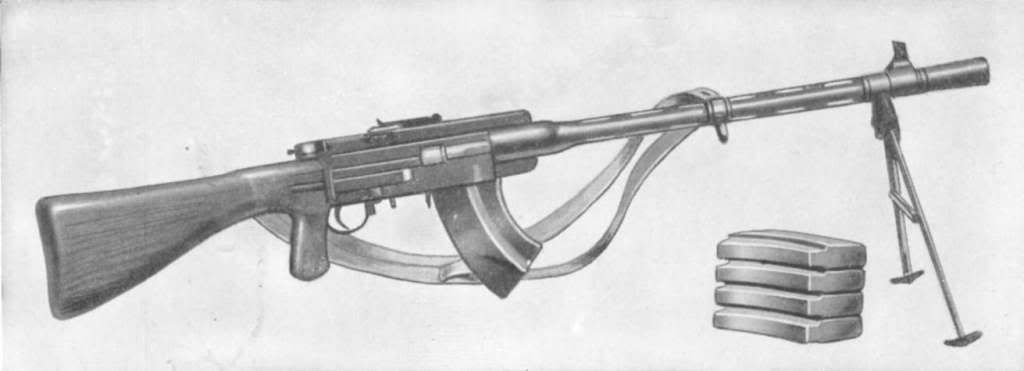
the functioning and the accuracy of the weapon were equally good as with the above-mentioned cartridges. It is accordingly fully possible to chamber the weapon for every known cartridge powerful enough to operate its mechanism.
"It must be pointed out as a noteworthy fact, that for countries that use cartridges of different calibers, this machine gun has one great advantage in that it is built exactly in the same way for all kinds of cartridges, with the exception of the easily exchanged recoiling parts which must be changed, of course, on account of differences in chamber and bore measurements. To the recoiling parts belong the barrel, barrel extension and bolt.
"It must be remembered that the receiver is absolutely the same for all recoiling units, so therefore the operational parts are changed as one piece, because the barrel is rigidly screwed together with the barrel extension. . . . All bolts are exactly the same in appearance and dimension provided the cartridge rims do not differ too much. In that case the bolt must also be exchanged. For instance, when firing 7.92-mm, 7.7-mm, and 6.5-mm caliber cartridges it is not necessary to change the bolt because the difference in diameter of the cartridge rims is so insignificant with these cartridges that it does not cause any disturbance in functioning.
"There is another advantage which must be observed also and that is that in a state of war, in case of capture of any of the above kinds of cartridges, this machine gun can use the ammunition by putting in other operating parts in their own receivers. . . .
"These changes can be made during the actual fighting and they would only take some eight seconds to perform, provided the necessary operating parts are brought along by the machine gun section. Every state, however, knows its possible future opponent in war, and what kind of ammunition they will use and can always keep a certain number of exchange systems in stock."
The feed system is either a spring-loaded clip that holds 25 British caliber .303 or German 7.92-mm cartridges, or a flat drum magazine with a capacity of 75 rounds of the same ammunition. The weapon is chambered for either the British or German Army rifle cartridge, with a
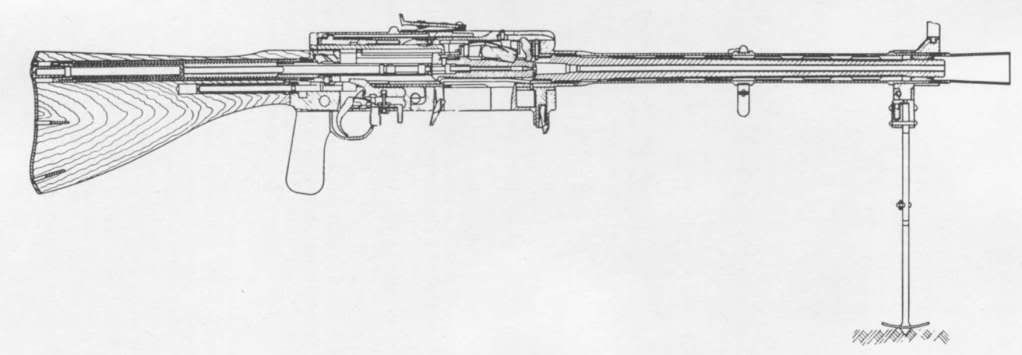
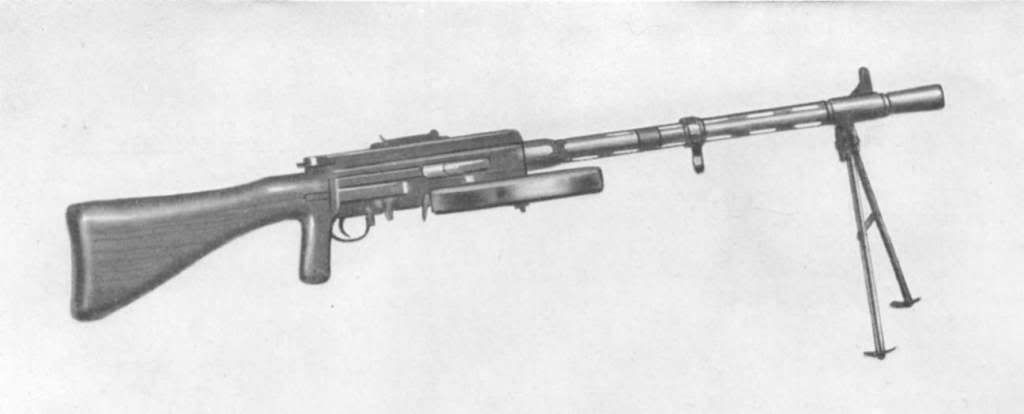
maximum rate of fire given as 500 shots a minute. The safety device operates so that, when the slide in front of the trigger is pressed back as far as it will go, a projection comes up under the sear. This makes it impossible to pull it down for release until the device is again moved forward.
For semiautomatic fire, the selector switch is moved off the safe position. As the trigger is pulled, the connector moves downward and draws the sear with it, releasing the bolt. Further pull on the trigger causes a nose on the front end of the connector to turn the latter around on the axle, whereby it is disengaged from the sear. This piece, under spring influence, engages its recess in the bolt before going forward to fire another shot.
The operator must release the trigger so that the connector may again engage the toe of the sear. Another pull on the trigger releases the sear to repeat the two distinct movements necessary for single shot firing.
To change either the conventional box-type magazine or the drum-shaped one, the magazine catch is pressed and the empty magazine removed by pulling down. A fresh one is then inserted, after observing that the holding catches are correctly engaged.
A loaded round cannot be left in the chamber of a hot barrel after a burst of long duration, as the bolt is automatically held to the rear after releasing the trigger. This not only prevents a cook-off but allows cool air to circulate through the open bore.
The barrel may be removed in a few seconds merely by turning the lever 180 degrees. This releases the catch holding the butt stock to the receiver. Then after lifting the receiver cover, the barrel extension with barrel and bolt can be pulled out to the rear. A cool barrel complete with extension and bolt is then inserted in place of the hot one. To prevent disassembly of the barrel and its hot members, the whole operating unit is changed.
To fire the L/S 26-32 light machine gun, the operator, if using the flat 75-shot drum, first removes the magazine support and pushes the drum up until its holding latch snaps. From the prone position, the charging handle is grasped by the right hand and pulled all the way to the rear. At this point the rising spring-loaded sear engages the notch in the bottom of the bolt, holding it to the rear. The weapon being cocked and ready to fire, the selector switch is moved from Safe to Automatic fire and the trigger pulled.
As the sear disengages the bolt, it is thrust forward by the energy of the compressed driving spring. The feed rib on top of the bolt shoves the first round out of the lips of the magazine and starts to chamber it. At a distance of one-half inch out of battery, the bolt seats behind the cartridge and the extractor claw snaps over its rim. At the same time the bolt-locking piece is cammed down into its locking notch on the bolt and this act releases the holding device that has been keeping the barrel and extension to the rear.
The locked barrel, its extension and its bolt start final movement forward and at a point one-sixteenth inch from full battery position a pivoting pin in the tip of the bolt body that has been in the path of the retracted firing pin contacts a ramp in the receiver and is levered up out of the way. The firing pin is now released to fly forward, striking the primer. The timing is such that recoil forces of the exploding powder charge are set up before the fast traveling locked mass strikes the solid receiver, thus utilizing these forces to buff the action.
The recoiling parts are locked securely together for a distance of a half inch; the stud on the bolt lock then engages a cam in the receiver that lifts it out of its locking recess. The movement is done in such a manner as to allow the bolt to creep a few thousandths of an inch rearward before total unlocking. This permits the extractor to break the gas seal and fully loosen the cartridge during this phase. At the instant of firing, energy is transferred from the fast recoiling barrel to the bolt by means of an accelerator, which, upon pivoting, speeds the bolt to the rear with the extractor holding the empty cartridge case. When its rim strikes the solid ejector, it is knocked out of the slot in the right side of the gun.
The first recoil movement starts to jack the firing pin to the rear and continues to do so until its sear in the top of the bolt drops in front of the circular projection over the body of the pin. The barrel and its extension at the moment of bolt release is held in a retracted position by its holding latch. When the bolt has reached its final recoil stroke, compression of the driving spring starts it into counterrecoil to repeat the cycle.
http://www.ibiblio.org/hyperwar/USN/ref ... html#lahti
